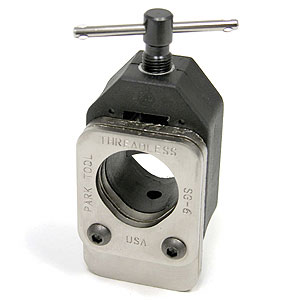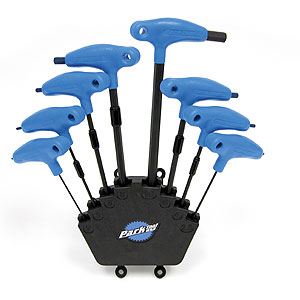Tools every bike tinkerer needs

There is nothing wrong with having your local wrench do his thing on your bike. But there's no sin against doing it yourself. Should you decide to take on the challenge of your bike's care and feeding, below is a list of items that ought to equip you nicely.
This list is in addition to a variety of home workshop tools and machines that I recommend. I write about that in another article, the link to which sits just below this article. Included in the other article is the bike stand.
What I'm including herein will give you a big head start. You'll be able to do most of what you need to do to your bike with these tools, keeping in mind, again, that general shop tools (pliers, hammer, hacksaw, bench vise) are not included in this list. What's below are the bike-specific tools. What won't you be able to do with the tools below? You won't be able to install a headset, even an internal headset, unless you can press on a crown race seat. There are no crown race installer removers here.
Also, there are no thread chasers, facers, nothing like that. What we're assuming is that the threads are good in your frame, and the surfaces are square.
I'll not go into a lot of detail on each of these tools, because I'm going into detail on select tools individually in later articles.
One other thing deserves mention. There is a site, Bike Tools Etc., and it's a place you can order just about all these tools online. It's a great resource. At the same time, there is a place we in the biz buy a lot of our tools: United Bicycle Tool & Supply. It has no functional website as of this writing. You can call them at 800-225-8287 or 541-482-1750. They are less brick-and-mortar stringent than the rest of the wholesale bike biz, and if you have a business license, a resale license, or proof you're a non-profit, you should be able to open up a wholesale account.
So, that said, and with no further introduction, here are the tools you really need to take care of your bike, with a rough cost attached per tool.
– Shop chain tool. Get the Park CT3. It'll cost $20 to $30.
– You'll need a cartridge bottom bracket tool, aka a spline tool, and you'll either get one that works for Shimano or Campagnolo, depending on what you ride. This should cost you $5 to $10.
– You'll need another spline tool to remove or to install and tighten your cassette lock ring. This tool for Shimano is Park Tool designation FR5 and it'll cost you $5 or $6.
– While I just told you to buy a spline tool for installing and removing today's bottom brackets, I'd still recommend getting an old-style square taper BB puller, because sometimes the spline type cranks get a bit sticky and don't just fall off when you take out the bolts that hold them in. The one you best get works both for old style squarehole BBs and also works nicely for the purpose just described, and it is Park Tool part number CWP-6. It'll sell for around $15.
– With that cassette lockring pulled, you'll need a chain whip to make it work. It should cost you between $15 and $20.
– One of my favorite bike tools, which sometimes gets used for things not bike related, is Park Tool's miter block, part number SG-6. It'll cost you from $20 to $30. It's held by your bench vise, and it's what's pictured at the top of this article.
– You'll need a tubing cutter, that is, the sort of cutter you might use to cut electrical conduit. You can get it anywhere, a half-decent one will cost around $30.
– A cable and housing cutter, aka "side pulls", is a must. Two ways you can go on this: full bore, in which case it's $75 for a set of Felco cutters; or else $25 or $30 for very acceptable but not-Felco cutters.
– You'll need some spoke wrenches, the single wrenches with plastic dipped color coded circular handles are what you want. It's the black one you'll need most of the time, for high end bikes, but sometimes those automatic spoke tensioning machines that build the OEM wheels can play havoc with the nipples. In this case you might need to resort to the green (slightly wider aperture) wrench: $10 to $15 for the pair.
– Get yourself a good pedal wrench, something with a long handle, sturdy. You can't get buy spending less than $20.

– Park makes the best set of allen wrenches going, it's part number is PH1, you'll get the following, in metric sizes: 2, 2.5, 3, 4, 5, 6 & 8mm P-handle hex wrench set. It'll cost between $40 and $60 for the set. It's pictured.
– Notwithstanding that great allen set, you'll need a set of simple L-shaped allens. Get them anywhere.
You'll need lubricants and liquids, in particular:
– Grease
– Lubricating oil
– Degreaser
– Cutting oil
– Get a batch of universal brake cables, stainless, at least a set of 10, and these will be 1.6mm in outer diameter. They'll cost you $1.20 to $2 per cable.
– Shift cables are different, 1.1mm outer diameter, and $80 to $120 will buy you 100 stainless cables. Just get this big batch and you'll have cables for the rest of your life. Just know that if you're really tall and you have a long run of cable, you might find that you need a tandem cable for the rear derailleur. But, this is really rare.
– Brake housing: 5mm outer diameter, you'll get a box of 50 meters worth for $25 to $30.
– Shift housing comes in either 5mm outer diameter or 4mm. I recommend 5mm because of these long runs of shift cable triathletes use, and a 50 meter box will cost between $50 and $80.
– Ferrules: a jar of 5mm crimpable ferrules, 200 count, the more expensive CNC variety, will cost you between $50 and $80. Get these better ferrules, because the cheaper ones give out easily. The more expensive is United Bicycle part number JW1153.
– Buy Jagwire's cable ends, and a jar of 500 for the thicker brake cables will cost you between $9 and $15.
– A jar of similar ferrules, same price, but the smaller size needed for shift cables.
Then you'll need the good Velox handlebar plugs, the rubber ones that wedge in, or at least the Kool Stop metal ones that won't easily fall out. Handlebar tape you'll need as well, good cork padded tape, and many rolls of black electrical tape.
What will all this cost? You should budget about $500 for everything above. You should be able to build a bike from the bottom up, excepting the tool used to seat the crown race onto the fork. For that, add between $50 and $100, depending on whether you also want the tool to get the crown race off again. I have also not included a wheel truing stand. These can cost between $50 and $250. In a pinch, with your bike in your shop stand, you can true the wheel using the brake calipers as gauges. Not perfect, but if you're not a wheel truer you won't need the truing stand.


